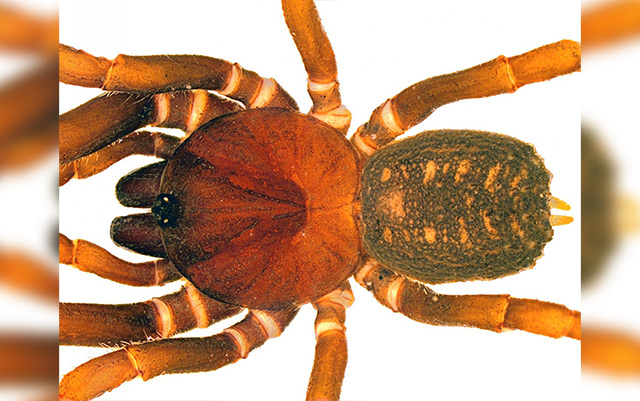
Dubbed Stormtropis, the new genus joins the bald-legged spiders (family Paratropididae). The arachnids flourish throughout most of Central America and South America.
Despite their wide distribution, bald-legged spiders didn't seem to live in Colombia. The half-dozen new species of Stormtropis disproved this, being some of the first examples found in that country.
All species of bald-legged spiders share the same small to medium size, body markings, and the ability to hide from predators through camouflage. They look so much alike that different species may be mistaken for each other.
Researchers from the Universidad de la Republica in Uruguay and their local colleagues at the Universidad Nacional de Colombia reported on the previously undiscovered Colombian spiders.
Four of the new species didn't fit existing Paratropididae genera. Their discoverers whipped up the new genus name Stormtropis for them. (Related: Understanding innate fears: Scientists study why snakes and spiders evoke a stress response, even in babies.)
New genus of bald-legged spiders are just as clumsy as Star Wars stormtroopers
The stormtroopers are the soldiers of the Galactic Empire in the Star Wars franchise. Individuals troopers are indistinguishable from each other. They use a semblance of camouflage to hide their bone-white armor and are clumsy enough to walk into doors.
In their report, the researchers remarked that the four species of the Stormtropis genus share more or less the same appearance. The spiders know how to use their surroundings to camouflage themselves, but are oddly clumsy.
Just as stormtrooper armor accumulated dirt and sand in the Star Wars movies, the cuticle of the Stormtropis spiders attracted particles of dirt and soil. The arachnids took advantage of this by scrabbling dirt on their scaly backs, making them look like the ground they lived in and allowing them to evade the eyes of predators.
“These soldiers are very similar to each other, with some capacity for camouflage, but with unskillful movements, like this new group of spiders,” explained UdelaR researcher Dr. Carlos Perafan, the co-author of the study. “We wanted to make a play on words with the name of the known genus, Paratropis, and of course, we also wanted to pay tribute to one of the greatest sagas of all time.”
Stormtropis spiders either live the high life or dig into dirt
Perafan and his teammates discovered one of the Stormtropis species in an area in the central Andes mountains that towered 11,1155 feet (3,400 m) above sea level. They also found evidence of other species living at even higher elevations that exceeded 13,122 feet (4,000 m).
The feet of male arachnids from most species of bald-legged spiders have three claws. Stormtropis males only have two claws – they also lack the leg spines of the former.
Male Stormtropis spiders also have longer reproductive organs. The ones on their females resemble mushrooms and have a tubular section.
With their discovery of the Stormtropis genus, the researchers dispelled the notion that bald-legged spiders didn't live in Colombia. Furthermore, they found that the spiders flourished in the country and behaved in unique ways.
They recorded several instances of different species of bald-legged spiders digging into the soil or the earthen walls of ravines. The burrowing behavior was unprecedented for the genus.
The researchers theorized that the burrowing activity was a secondary adaptation of the bald-legged spiders in Colombia. The behavior allowed the arachnids to exploit new environments.
Sources include:
Please contact us for more information.























